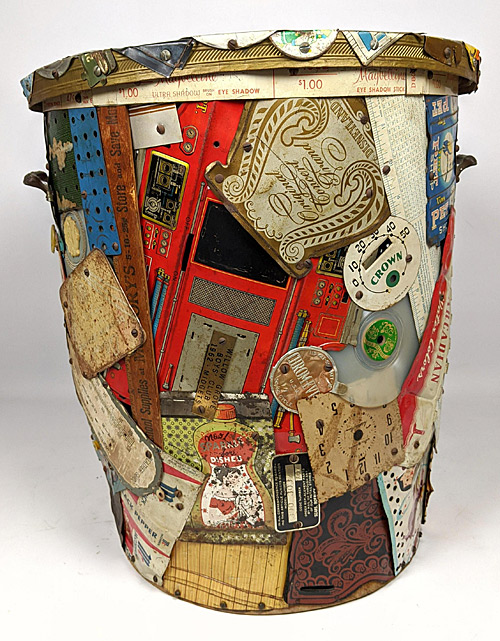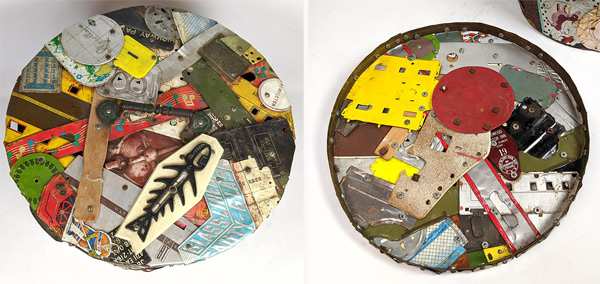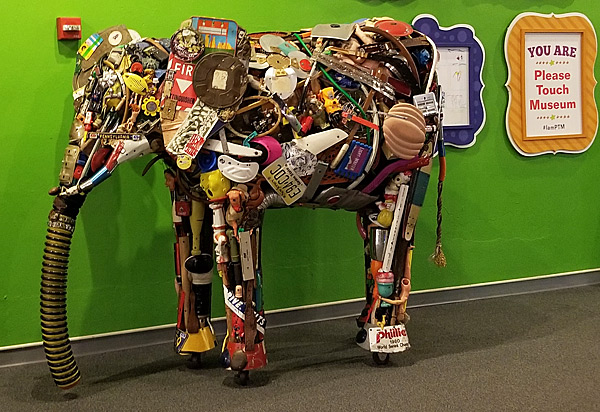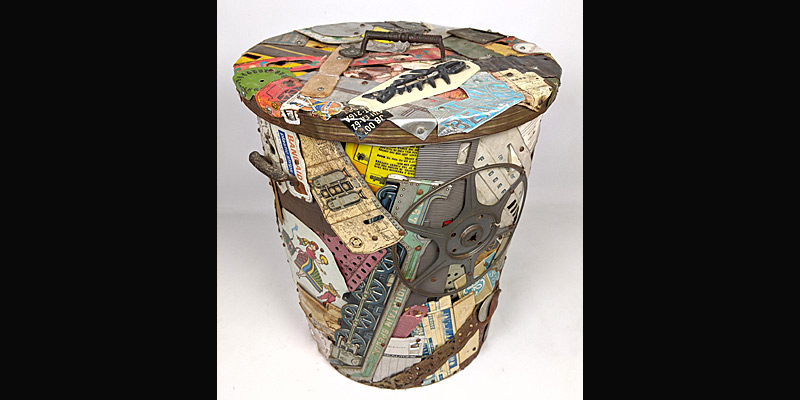The trash can touched on a memory. So did the name. There was something familiar about its style, colors, and the cacophony of shapes and pieces plastered onto it.
The auction house listed it as “Leo Sewell Lidded Can Sculpture.” Was this the same Leo Sewell who created the humongous replica of the arm and torch of the Statue of Liberty that stands impressively in the great hall at the Please Touch Museum in Philadelphia?
I saw the can on the auction-house website since that’s how I’m visiting auctions these days. I was browsing to see what artwork I could find that I could perhaps afford. Sewell’s creation was the first listing on the first day of the auction house’s recent two-day sale. It was in the shape of one of those metal trash cans.

The can stopped me in place in much the same way as the torch when I first entered the Please Touch Museum. Although much smaller (17 ½” tall), the can was just as lovely. On the wooden bottom, Sewell signed his name in ball-point-pen ink and wrote 1972 as the year it was made and 1982 as the year it was signed. His name is written a second time in larger red ink.
He constructed the 40-foot arm and torch in 2008 when the museum opened in its current location in Fairmount Park.
Sewell is a Philadelphia artist who uses the junk most of us throw away, fetching all manner of items that he transforms into beautiful sculptures of color. On his website, he describes himself as a “junk sculptor.” He is among artists through the years who use found objects as their medium – popularized by the French artist Marcel Duchamp most notably in the form of a urinal in 1917. African American artist David Hammons is considered one of the contemporary best of them.
Sewell grew up near a dump, “fell in love with junk, wanted to play with it,” he says in a 2010 video by John Thornton Films. His father taught him how to use tools so he could make something of the stuff he collected. He was born in Annapolis, MD, to parents who lived through the hard times of the Depression. “So you had to create or do stuff. It wasn’t about art, it was about an ethic, a Puritan ethic,” he says.

In 1963, he went to the University of Delaware to become a chemist, but ended up with an economics degree after becoming interested in advertising. He earned a master’s in Art History at the university. He learned his craft on his own, even writing about the art of using found objects as his master’s thesis.
“Art can be anything,” Sewell says in the video. During the 1960s, he saw some unorthodox representations of art. “So I thought, ‘Well, Gee, I’ll do my junk thing and call it art.'” That’s when he got started, creating his art while he worked other jobs.
His first works were abstract pieces that when finished “looked like a pile of junk,” he says in the video. Then he switched to works that looked real.

Sewell’s materials include metal, wood, plastic and other stuff that he finds at flea markets, yard sales and in the trash. He is a member of a group called Philadelphia Dumpster Divers. See him at work in this PBS video.
For the arm and torch, he used old toys and other items, some of which were donated by children. A duck sculpture contains a decoy, wings and other items pertaining to ducks.
In 1983, he made a seven-foot elephant named Artie that is also on display at the museum. This is a children’s museum located in the only building left standing from the 1876 Centennial Exposition. It was built as Memorial Hall, one of 200 buildings on the site. A replica of the arm and torch stood on the grounds.

Sewell has created more than 4,000 works over 50 years. They range from tabletop items such as a frog to 40-foot installations such as the arm and torch. His subjects are primarily animals, but he also produces people and things – including a wall mount of a lobster, a lady sitting on a stool with legs crossed and a 10-foot Samsonite suitcase fitted with license plates.
“These objects are chosen for their color, shape, texture, durability and patina, then they are assembled using nails, bolts, and screws,” he says on his website. “The outdoor sculptures are constructed of stainless steel, brass or aluminum found objects which are welded together.”
Sewell not only does commissions for museums and corporations but also for individuals who want an art assemblage of their favorite pet. “People want their things to have new life and that’s why I exist,” he says in the PBS video. “I love my job.”
As for the can, it sold for $750 (without the 25 percent buyer’s premium).




